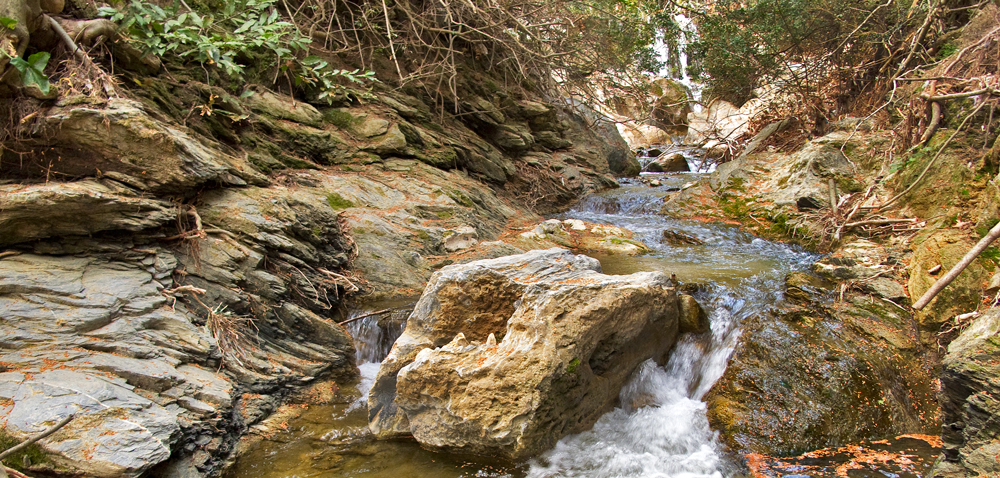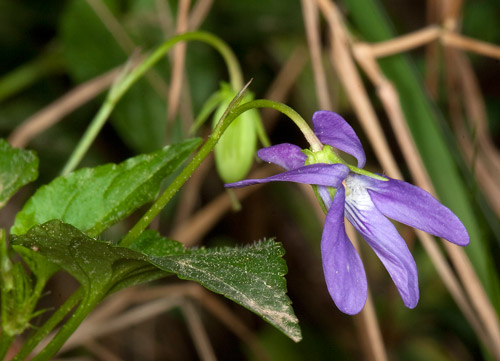Streams
Penteli-Chalandri stream

A beautiful stream that crosses the northern suburbs of Athens and remains an important habitat for many species of plants and animals. Also known as the Polydroso stream, its history goes back centuries, since its waters provided the perfect conditions for the first settlements of the area. Remnants of old times, such as dams, water mills and old buildings lie all along the route. The ancient road along which the marbles of Penteli mountain were transported for the construction of the Parthenon, passed through here. It is believed that a sanctuary of the goddess Dimitra was close to the stream. The stream originates from the southwest of Penteli mountain and follows a south-southwest course passing through the municipalities of Nea Penteli, Melissia, Vrilissia and Chalandri before following an underground course at the height of Filothei and flowing a few kilometres later into the Podoniftis river. The route, in which the stream is open and relatively accessible at various points, reaches 8.3 km. Its meandering route, lush vegetation and small waterfalls are impressive, elements that belong more to a small river of a mountain forest than to a stream that runs parallel to the urban landscape of Athens. It is no exaggeration that the Penteli-Chalandri stream is one of the last wild habitats of the city.
The banks of the stream are densely covered with oriental planes, aleppo pines, mediterranean cypresses, poplars, oleanders and chaste trees. A few metres higher up grow kermes oaks, wild olives trees, lentiscs, turpentines, carob trees, almond trees, wild pears, eucalypts, myrtles, strawberry trees, heaths, hairy thorny brooms, weaver’s brooms, bay trees, rockroses and thymes. On the banks there are clumps of reeds. Blackberries, ivies, hedge bindweeds and privets make access impassable in many spots. Near the stream grow huge bear’s breeches (Acanthus mollis), the impressive plant which, according to Vitruvius, was the model for the Corinthian capitals. Important plants of the surrounding area are: Silene pentelica, Centaurea attica subsp. attica, Colchicum atticum, Helianthemum hymettium, Viola odorata, Narcissus tazetta subsp. tazetta, Echinops graecus, Onosma frutescens, Anemone blanda subsp. blanda and Crocus cancellatus subsp. mazziaricus. Other species growing near the stream are: Asplenium ceterach, Asplenium trichomanes, Equisetum palustre, Anogramma leptophylla, Allium subhirsutum, Sternbergia lutea subsp. lutea, Bupleurum fruticosum, Smyrnium olusatrum, Vinca major subsp. major, Arum italicum subsp. italicum, Biarum tenuifolium subsp. abbreviatum, Dracunculus vulgaris, Asparagus acutifolius, Asphodelus fistulosus, Bellis annua subsp. annua, Calendula arvensis, Helichrysum luteoalbum, Leontodon tuberosus, Tragopogon porrifolius subsp. eriospermus, Tussilago farfara, Alkanna tinctoria subsp. tinctoria, Echium italicum subsp. biebersteinii, Petrorhagia dubia, Carex distans, Carex hispida, Lomelosia brachiata, Globularia alypum, Muscari commutatum, Ornithogalum collinum subsp. collinum, Prospero autumnale, Hypericum empetrifolium subsp. empetrifolium, Cyclamen graecum subsp. graecum, Iris tuberosa and Romulea bulbocodium. The orchids growing here are Anacamptis pyramidalis, Himantoglossum robertianum, Orchis anthropophora, Orchis italica, Ophrys attica, Ophrys sicula, Ophrys tenthredinifera, Ophrys ferrum-equinum, Ophrys leucadica and Ophrys mammosa.
The presence of birds is rich in the stream, as it offers the appropriate protection in the inhospitable urban landscape. Common buzzards, common sparrowhawks and common kestrels hunt around the stream. Little owls, scops owls, tawny owls and surprisingly barn owls live in the forest. Woodcocks and woodpigeons rest here during their migration, while white storks occasionally stop in the nearby fields. Chukar partridges live close to Penteli and jays are fairly common. Other species found here are turtle doves, swifts, swallows, house martins, hoopoes, tree pipits, white wagtails, yellow wagtails, wrens, dunnocks, robins, redstarts, black redstarts, song thrushes, blackbirds, blackcaps, sardinian warblers, subalpine warblers, whitethroats, olivaceous warblers, chiffchaffs, goldcrests, spotted flycatchers, pied flycatchers, great tits, blue tits, long-tailed tits, starlings, chaffinches, goldfinches, greenfinches, serins and hawfinches.
In areas where the waters are calm live impressive numbers of common toads. Other amphibians are green toads and agile frogs. The herpetofauna of the stream is rich and includes marginated tortoises, Hermann’s tortoises, Mediterranean house geckos, Βalkan green lizards, Erhard’s wall lizards, snake-eyed skinks, ocellated skinks, glass lizards, four-lined snakes, Dahl’s whip snakes, cat snakes, leopard snakes and grass snakes. The mammals of the area are eastern hedgehogs, foxes and various species of bats. Unfortunately, the stream is no longer home to fishes, as the chubs that live in Podonifti river have been cut off due to artificial raises in the bed. Interestingly, over 50 species of butterflies have been recorded in the area, including Iphiclides podalirius, Papilio machaon, Zerynthia polyxena, Pieris brassicae, Pieris rapae, Pontia daplidice, Euchloe ausonia, Anthocharis cardamines, Colias croceus, Gonepteryx cleopatra, Leptidea sinapis, Callophrys rubi, Lycaena phlaeas, Lampides boeticus, Pseudophilotes vicrama, Aricia agestis, Polyommatus icarus, Limenitis reducta, Vanessa atalanta, Vanessa cardui, Melanagria larissa, Hipparchia syriaca, Maniola jurtina, Coenonympha pamphilus, Paragre aegeria, Lasiommata megera, Spialia orbifer, Carcharodus alceae, Thymelicus sylvestris and Arctia festiva.
The banks of the stream are densely covered with oriental planes, aleppo pines, mediterranean cypresses, poplars, oleanders and chaste trees. A few metres higher up grow kermes oaks, wild olives trees, lentiscs, turpentines, carob trees, almond trees, wild pears, eucalypts, myrtles, strawberry trees, heaths, hairy thorny brooms, weaver’s brooms, bay trees, rockroses and thymes. On the banks there are clumps of reeds. Blackberries, ivies, hedge bindweeds and privets make access impassable in many spots. Near the stream grow huge bear’s breeches (Acanthus mollis), the impressive plant which, according to Vitruvius, was the model for the Corinthian capitals. Important plants of the surrounding area are: Silene pentelica, Centaurea attica subsp. attica, Colchicum atticum, Helianthemum hymettium, Viola odorata, Narcissus tazetta subsp. tazetta, Echinops graecus, Onosma frutescens, Anemone blanda subsp. blanda and Crocus cancellatus subsp. mazziaricus. Other species growing near the stream are: Asplenium ceterach, Asplenium trichomanes, Equisetum palustre, Anogramma leptophylla, Allium subhirsutum, Sternbergia lutea subsp. lutea, Bupleurum fruticosum, Smyrnium olusatrum, Vinca major subsp. major, Arum italicum subsp. italicum, Biarum tenuifolium subsp. abbreviatum, Dracunculus vulgaris, Asparagus acutifolius, Asphodelus fistulosus, Bellis annua subsp. annua, Calendula arvensis, Helichrysum luteoalbum, Leontodon tuberosus, Tragopogon porrifolius subsp. eriospermus, Tussilago farfara, Alkanna tinctoria subsp. tinctoria, Echium italicum subsp. biebersteinii, Petrorhagia dubia, Carex distans, Carex hispida, Lomelosia brachiata, Globularia alypum, Muscari commutatum, Ornithogalum collinum subsp. collinum, Prospero autumnale, Hypericum empetrifolium subsp. empetrifolium, Cyclamen graecum subsp. graecum, Iris tuberosa and Romulea bulbocodium. The orchids growing here are Anacamptis pyramidalis, Himantoglossum robertianum, Orchis anthropophora, Orchis italica, Ophrys attica, Ophrys sicula, Ophrys tenthredinifera, Ophrys ferrum-equinum, Ophrys leucadica and Ophrys mammosa.
The presence of birds is rich in the stream, as it offers the appropriate protection in the inhospitable urban landscape. Common buzzards, common sparrowhawks and common kestrels hunt around the stream. Little owls, scops owls, tawny owls and surprisingly barn owls live in the forest. Woodcocks and woodpigeons rest here during their migration, while white storks occasionally stop in the nearby fields. Chukar partridges live close to Penteli and jays are fairly common. Other species found here are turtle doves, swifts, swallows, house martins, hoopoes, tree pipits, white wagtails, yellow wagtails, wrens, dunnocks, robins, redstarts, black redstarts, song thrushes, blackbirds, blackcaps, sardinian warblers, subalpine warblers, whitethroats, olivaceous warblers, chiffchaffs, goldcrests, spotted flycatchers, pied flycatchers, great tits, blue tits, long-tailed tits, starlings, chaffinches, goldfinches, greenfinches, serins and hawfinches.
In areas where the waters are calm live impressive numbers of common toads. Other amphibians are green toads and agile frogs. The herpetofauna of the stream is rich and includes marginated tortoises, Hermann’s tortoises, Mediterranean house geckos, Βalkan green lizards, Erhard’s wall lizards, snake-eyed skinks, ocellated skinks, glass lizards, four-lined snakes, Dahl’s whip snakes, cat snakes, leopard snakes and grass snakes. The mammals of the area are eastern hedgehogs, foxes and various species of bats. Unfortunately, the stream is no longer home to fishes, as the chubs that live in Podonifti river have been cut off due to artificial raises in the bed. Interestingly, over 50 species of butterflies have been recorded in the area, including Iphiclides podalirius, Papilio machaon, Zerynthia polyxena, Pieris brassicae, Pieris rapae, Pontia daplidice, Euchloe ausonia, Anthocharis cardamines, Colias croceus, Gonepteryx cleopatra, Leptidea sinapis, Callophrys rubi, Lycaena phlaeas, Lampides boeticus, Pseudophilotes vicrama, Aricia agestis, Polyommatus icarus, Limenitis reducta, Vanessa atalanta, Vanessa cardui, Melanagria larissa, Hipparchia syriaca, Maniola jurtina, Coenonympha pamphilus, Paragre aegeria, Lasiommata megera, Spialia orbifer, Carcharodus alceae, Thymelicus sylvestris and Arctia festiva.
Πως θα πάτε
The stream runs parallel to Pentelis avenue from Nea Penteli to Chalandri. In many places it offers convenient access. Be careful because there are no easy and clear paths and never visit the bed after rain as the water can become raging.Εμφάνιση στο χάρτη
click to see the place on the map(Latitude: 38.04483148908956, Longitude:23.83304702164196)
Social Networks
Also Read

Arkoudorema - Valia Kalda
Arkoudorema is an impetuous stream in the heart of the National Park of Valia Kalda, in one of the most wild and pristine areas of Greece.

Tsouvala
A little stream of mountain Kissavos that looks like it came out from a fairytale and is distinguished by its dense vegetation and the presence of a small waterfall.













